Input density tunes Kenyon cell sensory responses in the Drosophila mushroom body
- PMID: 37348501
- PMCID: PMC10529417
- DOI: 10.1016/j.cub.2023.05.064
Input density tunes Kenyon cell sensory responses in the Drosophila mushroom body
Abstract
The ability to discriminate sensory stimuli with overlapping features is thought to arise in brain structures called expansion layers, where neurons carrying information about sensory features make combinatorial connections onto a much larger set of cells. For 50 years, expansion coding has been a prime topic of theoretical neuroscience, which seeks to explain how quantitative parameters of the expansion circuit influence sensory sensitivity, discrimination, and generalization. Here, we investigate the developmental events that produce the quantitative parameters of the arthropod expansion layer, called the mushroom body. Using Drosophila melanogaster as a model, we employ genetic and chemical tools to engineer changes to circuit development. These allow us to produce living animals with hypothesis-driven variations on natural expansion layer wiring parameters. We then test the functional and behavioral consequences. By altering the number of expansion layer neurons (Kenyon cells) and their dendritic complexity, we find that input density, but not cell number, tunes neuronal odor selectivity. Simple odor discrimination behavior is maintained when the Kenyon cell number is reduced and augmented by Kenyon cell number expansion. Animals with increased input density to each Kenyon cell show increased overlap in Kenyon cell odor responses and become worse at odor discrimination tasks.
Keywords: Drosophila melangaster; Marr-Albus theory; brain engineering; development; expansion layer; mushroom body; neural network; olfaction; pattern separation.
Copyright © 2023 Elsevier Inc. All rights reserved.
Conflict of interest statement
Declaration of interests The authors declare no competing interests.
Figures
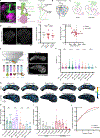

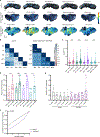
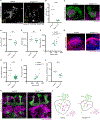
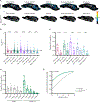
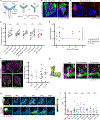

Similar articles
-
Presynaptic developmental plasticity allows robust sparse wiring of the Drosophila mushroom body.Elife. 2020 Jan 8;9:e52278. doi: 10.7554/eLife.52278. Elife. 2020. PMID: 31913123 Free PMC article.
-
Hacking brain development to test models of sensory coding.bioRxiv [Preprint]. 2023 Jan 26:2023.01.25.525425. doi: 10.1101/2023.01.25.525425. bioRxiv. 2023. PMID: 36747712 Free PMC article. Preprint.
-
Sparse, decorrelated odor coding in the mushroom body enhances learned odor discrimination.Nat Neurosci. 2014 Apr;17(4):559-68. doi: 10.1038/nn.3660. Epub 2014 Feb 23. Nat Neurosci. 2014. PMID: 24561998 Free PMC article.
-
Mechanisms underlying homeostatic plasticity in the Drosophila mushroom body in vivo.Proc Natl Acad Sci U S A. 2020 Jul 14;117(28):16606-16615. doi: 10.1073/pnas.1921294117. Epub 2020 Jun 29. Proc Natl Acad Sci U S A. 2020. PMID: 32601210 Free PMC article.
-
Olfactory learning skews mushroom body output pathways to steer behavioral choice in Drosophila.Curr Opin Neurobiol. 2015 Dec;35:178-84. doi: 10.1016/j.conb.2015.10.002. Epub 2015 Nov 3. Curr Opin Neurobiol. 2015. PMID: 26496148 Free PMC article. Review.
Cited by
-
Modeling and characterization of pure and odorant mixture processing in the Drosophila mushroom body calyx.Front Physiol. 2024 Oct 16;15:1410946. doi: 10.3389/fphys.2024.1410946. eCollection 2024. Front Physiol. 2024. PMID: 39479309 Free PMC article.
-
Spatial constraints and cell surface molecule depletion structure a randomly connected learning circuit.bioRxiv [Preprint]. 2024 Jul 21:2024.07.17.603956. doi: 10.1101/2024.07.17.603956. bioRxiv. 2024. Update in: Curr Biol. 2025 Jul 7;35(13):3191-3208.e10. doi: 10.1016/j.cub.2025.05.062. PMID: 39071296 Free PMC article. Updated. Preprint.
-
Diversity of visual inputs to Kenyon cells of the Drosophila mushroom body.Nat Commun. 2024 Jul 7;15(1):5698. doi: 10.1038/s41467-024-49616-z. Nat Commun. 2024. PMID: 38972924 Free PMC article.
-
Neuronal circuit mechanisms of competitive interaction between action-based and coincidence learning.Sci Adv. 2024 Dec 6;10(49):eadq3016. doi: 10.1126/sciadv.adq3016. Epub 2024 Dec 6. Sci Adv. 2024. PMID: 39642217 Free PMC article.
-
Sensory encoding and memory in the mushroom body: signals, noise, and variability.Learn Mem. 2024 Jun 11;31(5):a053825. doi: 10.1101/lm.053825.123. Print 2024 May. Learn Mem. 2024. PMID: 38862174 Free PMC article. Review.
References
-
- Wong AM, Wang JW, and Axel R (2002). Spatial representation of the glomerular map in the Drosophila protocerebrum. Cell 109, 229–241. - PubMed
-
- Marin EC, Jefferis GSXE, Komiyama T, Zhu H, and Luo L (2002). Representation of the glomerular olfactory map in the Drosophila brain. Cell 109, 243–255. - PubMed
Publication types
MeSH terms
Substances
Grants and funding
LinkOut - more resources
Full Text Sources
Molecular Biology Databases

